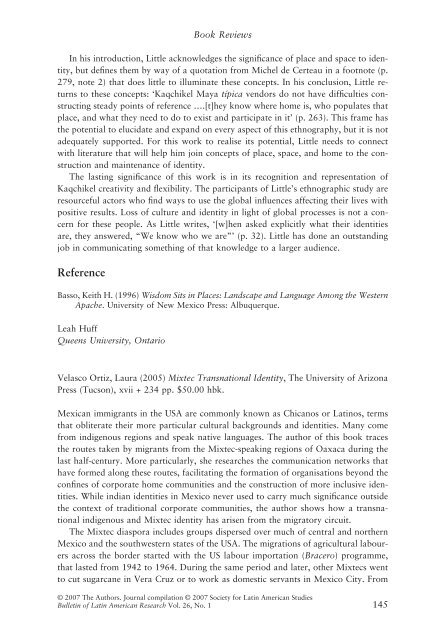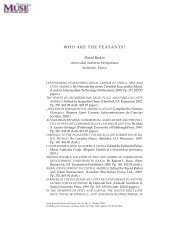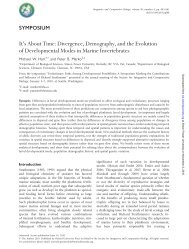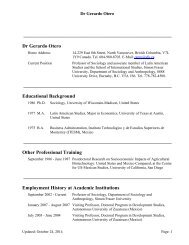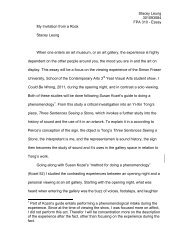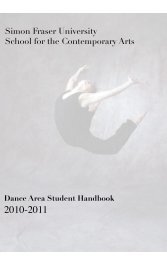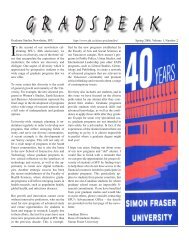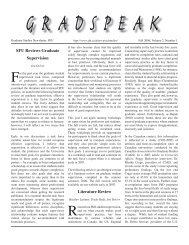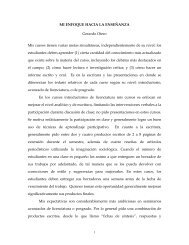Review of Mexico in Transition by Byron Crites
Review of Mexico in Transition by Byron Crites
Review of Mexico in Transition by Byron Crites
- TAGS
- transition
- byron
- crites
- cgi.sfu.ca
You also want an ePaper? Increase the reach of your titles
YUMPU automatically turns print PDFs into web optimized ePapers that Google loves.
Book <strong>Review</strong>s<br />
In his <strong>in</strong>troduction, Little acknowledges the signifi cance <strong>of</strong> place and space to identity,<br />
but defi nes them <strong>by</strong> way <strong>of</strong> a quotation from Michel de Certeau <strong>in</strong> a footnote (p.<br />
279, note 2) that does little to illum<strong>in</strong>ate these concepts. In his conclusion, Little returns<br />
to these concepts: ‘ Kaqchikel Maya típica vendors do not have diffi culties construct<strong>in</strong>g<br />
steady po<strong>in</strong>ts <strong>of</strong> reference … .[t] hey know where home is, who populates that<br />
place, and what they need to do to exist and participate <strong>in</strong> it ’ (p. 263). This frame has<br />
the potential to elucidate and expand on every aspect <strong>of</strong> this ethnography, but it is not<br />
adequately supported. For this work to realise its potential, Little needs to connect<br />
with literature that will help him jo<strong>in</strong> concepts <strong>of</strong> place, space, and home to the construction<br />
and ma<strong>in</strong>tenance <strong>of</strong> identity.<br />
The last<strong>in</strong>g signifi cance <strong>of</strong> this work is <strong>in</strong> its recognition and representation <strong>of</strong><br />
Kaqchikel creativity and fl exibility. The participants <strong>of</strong> Little ’ s ethnographic study are<br />
resourceful actors who fi nd ways to use the global <strong>in</strong>fl uences affect<strong>in</strong>g their lives with<br />
positive results. Loss <strong>of</strong> culture and identity <strong>in</strong> light <strong>of</strong> global processes is not a con -<br />
cern for these people. As Little writes, ‘ [w] hen asked explicitly what their identities<br />
are, they answered, “ We know who we are ” ’ (p. 32). Little has done an outstand<strong>in</strong>g<br />
job <strong>in</strong> communicat<strong>in</strong>g someth<strong>in</strong>g <strong>of</strong> that knowledge to a larger audience.<br />
Reference<br />
Basso , Keith H . ( 1996 ) Wisdom Sits <strong>in</strong> Places: Landscape and Language Among the Western<br />
Apache . University <strong>of</strong> New <strong>Mexico</strong> Press : Albuquerque .<br />
Leah Huff<br />
Queens University, Ontario<br />
Velasco Ortiz, Laura (2005) Mixtec Transnational Identity , The University <strong>of</strong> Arizona<br />
Press (Tucson), xvii + 234 pp. $50.00 hbk.<br />
Mexican immigrants <strong>in</strong> the USA are commonly known as Chicanos or Lat<strong>in</strong>os, terms<br />
that obliterate their more particular cultural backgrounds and identities. Many come<br />
from <strong>in</strong>digenous regions and speak native languages. The author <strong>of</strong> this book traces<br />
the routes taken <strong>by</strong> migrants from the Mixtec-speak<strong>in</strong>g regions <strong>of</strong> Oaxaca dur<strong>in</strong>g the<br />
last half-century. More particularly, she researches the communication networks that<br />
have formed along these routes, facilitat<strong>in</strong>g the formation <strong>of</strong> organisations beyond the<br />
confi nes <strong>of</strong> corporate home communities and the construction <strong>of</strong> more <strong>in</strong>clusive identities.<br />
While <strong>in</strong>dian identities <strong>in</strong> <strong>Mexico</strong> never used to carry much signifi cance outside<br />
the context <strong>of</strong> traditional corporate communities, the author shows how a transnational<br />
<strong>in</strong>digenous and Mixtec identity has arisen from the migratory circuit.<br />
The Mixtec diaspora <strong>in</strong>cludes groups dispersed over much <strong>of</strong> central and northern<br />
<strong>Mexico</strong> and the southwestern states <strong>of</strong> the USA. The migrations <strong>of</strong> agricultural labourers<br />
across the border started with the US labour importation ( Bracero ) programme,<br />
that lasted from 1942 to 1964. Dur<strong>in</strong>g the same period and later, other Mixtecs went<br />
to cut sugarcane <strong>in</strong> Vera Cruz or to work as domestic servants <strong>in</strong> <strong>Mexico</strong> City. From<br />
© 2007 The Authors. Journal compilation © 2007 Society for Lat<strong>in</strong> American Studies<br />
Bullet<strong>in</strong> <strong>of</strong> Lat<strong>in</strong> American Research Vol. 26, No. 1 145


